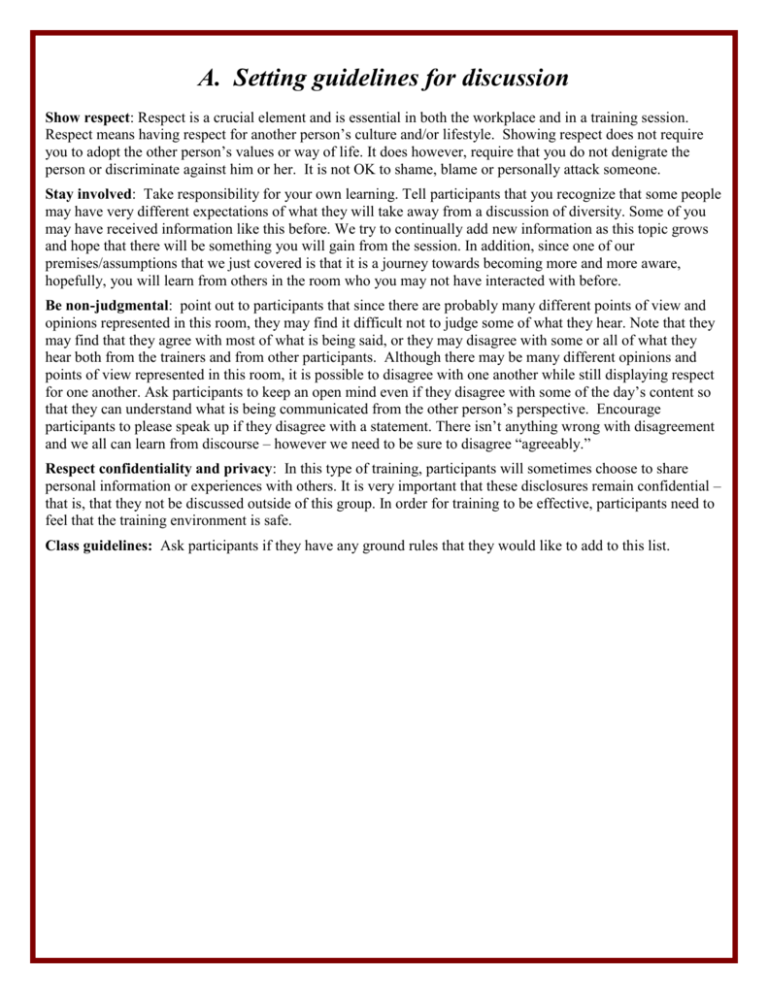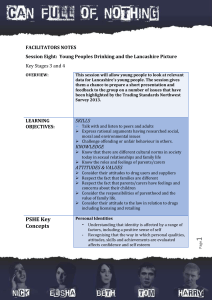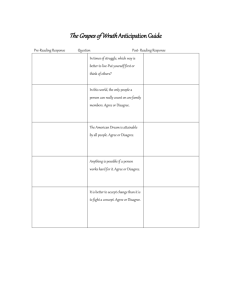diversity lesson pla.. - Stony Brook University
advertisement

A. Setting guidelines for discussion Show respect: Respect is a crucial element and is essential in both the workplace and in a training session. Respect means having respect for another person’s culture and/or lifestyle. Showing respect does not require you to adopt the other person’s values or way of life. It does however, require that you do not denigrate the person or discriminate against him or her. It is not OK to shame, blame or personally attack someone. Stay involved: Take responsibility for your own learning. Tell participants that you recognize that some people may have very different expectations of what they will take away from a discussion of diversity. Some of you may have received information like this before. We try to continually add new information as this topic grows and hope that there will be something you will gain from the session. In addition, since one of our premises/assumptions that we just covered is that it is a journey towards becoming more and more aware, hopefully, you will learn from others in the room who you may not have interacted with before. Be non-judgmental: point out to participants that since there are probably many different points of view and opinions represented in this room, they may find it difficult not to judge some of what they hear. Note that they may find that they agree with most of what is being said, or they may disagree with some or all of what they hear both from the trainers and from other participants. Although there may be many different opinions and points of view represented in this room, it is possible to disagree with one another while still displaying respect for one another. Ask participants to keep an open mind even if they disagree with some of the day’s content so that they can understand what is being communicated from the other person’s perspective. Encourage participants to please speak up if they disagree with a statement. There isn’t anything wrong with disagreement and we all can learn from discourse – however we need to be sure to disagree “agreeably.” Respect confidentiality and privacy: In this type of training, participants will sometimes choose to share personal information or experiences with others. It is very important that these disclosures remain confidential – that is, that they not be discussed outside of this group. In order for training to be effective, participants need to feel that the training environment is safe. Class guidelines: Ask participants if they have any ground rules that they would like to add to this list. B. Defining Diversity - Diversity Iceberg Explain to the participants that the purpose of this activity is to bring into focus the various manifestations of diversity that exist among people. Draw an iceberg on newsprint or on the blackboard. Make sure the water line splits the page so that about 1/3 of the iceberg appears above the water and that it is much larger below the water. Explain to participants that we use the analogy of an iceberg when defining diversity. Ask why we would use this? What are the qualities of an iceberg that are similar to diversity characteristics? Only about 10% of its mass is visible above the surface of the water. State that we are going to try to identify as many different dimensions of diversity as possible. You may say, “One of the things that I think of when I think of diversity is skin color or hair color. Since skin/hair color is very visible when you meet a person, I’m going to write it above the line.” Placing it above the line means that within the first 5 seconds of meeting someone, you can tell, without speaking or any other verbal cues. An example of one that might be placed below is education – just by looking at a person you do not know how many years they have been to school, what kinds of formal education they have received. Ask: “What additional characteristics do you think of when you think of diversity?” When someone gives you a response, ask whether or not they would place that characteristic on the page above or below the surface of the water. Trainer tips – important!! Allow whoever offers the characteristic to make the decision as to whether or not it belongs above or below the line – it is important not to debate that. It is important that the facilitator does not make the decision, but that the individual contributor or group does so. If you disagree, throw it back to the group and ask if everyone agrees that it should be above the line, and why someone might place it below instead. Processing questions: Where does the majority of the writing happen on the iceberg – above or below the water? What do we notice more- those characteristics above or below the water? Not all of these characteristics carry equal weight in the workplace, in society or in the classroom. Think about which ones are more important in different settings. Why are they important? Which characteristics have traditionally been “hot issues” in the workplace? Additional points to make: Diversity is very broad in scope. It is not just about race and ethnicity or visible differences. An iceberg is smaller on top and much larger below the surface – as you discuss diversity or discover different characteristics about someone else, it may not be apparent what lies below the water’s surface. Most of the writing is below the iceberg –many dimensions of diversity are hidden from view. For the most part, who we are as human beings is not at all visible to the eye. Yet what we often do is make unconscious, ‘snap’ judgments about people on the basis of the few characteristics that are 2 above the line i.e. visible to the eye. Become aware of when we are judging people based on superficial information and avoid stereotyping them.1 These additional definitions are provided to supplement those printed in the Freshman Seminar 101 text: Assimilation is taking on the traits of another culture, leaving the culture of origin behind. Acculturation is taking on one or more cultural traits of another group, resulting in new or blended cultures. Bias is a collection of learnings and experiences that shape our perceptions or “a subjective point of view.”i A distorted way of viewing things.ii Bias is natural, normal and unavoidable. Problems arise when we allow our biases to limit or cloud our thinking. Collusion is cooperation with others, knowingly or unknowingly to reinforce stereotypical attitudes, prevailing behaviors and norms. This is sometimes displayed by silence, denial or active cooperation. iii Culture is the way of life of a given society that is passed down from one generation to the next through learning and experience. It is the shared values, traditions, norms, customs, religion, arts, history, folklore, language and/or institutions of a specific group of people. Prejudice is a bias for or against something that is formed without a basis. It is an act of prejudging before evidence is considered. A set of attitudes in which misjudgment is generalized to a cultural group of people and is coupled with avoidance, stereotyping or fear of the group. Managing Diversity is the comprehensive management process for creating an environment that enables all members of a workforce to be productive, without advantaging or disadvantaging anyone. Multicultural refers to many cultures. It means valuing the differences of others and creating an environment that does not require leaving the culture of origin behind. In diversity work, it means valuing the differences of others and creating an environment that does not require assimilation. Sexual Harassment includes “Unwelcome” sexual advances, request for sexual favors, and other verbal or physical conduct of a sexual nature. These acts constitute sexual harassment when submission to or rejection of this conduct explicitly or implicitly affects an individual’s employment, work performance and create an intimidating, hostile work environment. Sexual Harassment may include practices ranging from direct requests for sexual favors to workplace conditions that create a hostile environment for persons of either gender, including same sex harassment. (The "hostile environment" standard also applies to harassment on the bases of race, color, national origin, religion, age, and disability.)iv Stereotypes are fixed or conventional notions that deny individuality and are based on limited information and interactions. They are inflexible views directed at a group of people. Stereotypes can prevent us from examining our learning and seeing reality. v All definitions have been revised and updated from: Diversity Activities and Training Designs, Julie O’Mara, Pfeiffer & Company, 1994 From: Cornell, School of Industrial and Labor Relations “Diversity management”, 2004 iii From: Cornell, School of Industrial and Labor Relations “Diversity management”, 2004 iv Revised from the Equal Employment Opportunity Commission’s website: http://eeoc.gov/facts/qanda.html v From: Diversity Activities and Training Designs, Julie O’Mara, Pfeiffer & Company, 1994 i ii 3 D. Understanding Stereotypes Diversity Scavenger Hunt A. Explain that the activity is designed as a way to get to know each other better. Tell the group that their task is to try to meet as many different individuals as possible and identify as many characteristics on their sheet as possible. B. Instructions to the group: 1. Hand out Scavenger Hunt Sheet (next page) 2. Select a symbol that they will use to represent themselves (For example, a star, a checkmark or a smiley face.) 3. Introduce yourself to another participant. 4. Ask your partner whether or not they identify with a particular fact. (For example: Ask your partner “Do you know sign language?” or “Are you an only child?”) 5. If your partner responds “Yes”, have them write their symbol on your page next to the statement that fits them. Once they respond yes, move on to the next person. 6. Important note: There is no need to go in order down the sheet, see if you can select a statement that your partner will say yes to on the first try. 7. Try to meet everyone in the room at least once and to get symbols for as many statements as possible. C. Give the group at least 5 minutes to circulate around the room and fill their sheet with symbols from other participants. D. These series of questions may begin a discussion on first impressions and the impact of stereotypes on meeting others: How many people received responses for more than 10 symbols/identifiers? …more than 12? ...more than 15? Who has the most responses? How did you like doing this exercise? Did you find it difficult? What were the questions that appealed to you the most in learning about others in the group? Invite people who responded yes to the knowledge based questions to share their answers – for example name the Native American nations, Latino ethnicities, Asian Ethnicities, African ethnicities, what Ramadan is, difference between salsa and merengue. Were there any categories that someone asked you that you were surprised that you were asked? Are there questions that you were consistently asked? Were there any categories that no one asked you? Why do you think this is the case? Were there any categories that you found difficult to ask about or that you tended to avoid? Why? (Usually people respond with identifying as gay, lesbian or bisexual, or someone dying of AIDS) How come we are more sensitized to these responses? Were you surprised by a ‘yes’ answer that someone gave to you? (For example, that someone responded yes when they stated that they ate Japanese food?) Why were you surprised? Sometimes your reactions and your approach to this activity are based on stereotypes that you may have of others. How are first impressions and stereotypes related? 4 How does this activity relate to the topic of Diversity? This activity includes many “dimensions of diversity”. What is meant by that term? Emphasize that diversity does not just include race but includes many different aspects of one’s background. 5 Scavenger Hunt Knows sign language Is an only child Was born outside of the US Is a 1st generation US citizen Can name 5 African Ethnic groups Eats Japanese, Indian, Thai food Has children Knows the difference between merengue & salsa Speaks more than 2 languages Has traveled to Europe Is bi-racial Celebrates Hanukah Is a vegetarian Knows someone who has died of AIDS Can name 5 different Latino ethnic groups Knows how to cornrow or what cornrows are Attends mass Has lived in more than 3 states Can name 2 countries that use fingers to eat Practices meditation Knows what Ramadan is Is left handed Can name 5 Native American Nations Was born and raised in Long Island Was raised in a single parent household Can name 7 different Asian ethnic groups Knows what "nan" (food) is Has 3 siblings or more Has lived in another country Knows what country "injera" bread is from Identifies as gay, lesbian, bisexual, or transgendered Married someone of a different cultural/ethnic group Has a child under 5 Prays before a meal Plays piano Is the middle child Has dinner with extended family every weekend Speaks w/ an accent Was born and raised in NYC Has ever had to use crutches 6 Typical questions from students and issues to be aware of when conducting diversity awareness activities: Comment I treat everyone the same. I don’t see color, I see people as people. You can’t change people’s beliefs, they are who they are. Possible Responses Do you think that all people want to be treated the same way? Do you want to be treated like everyone else? Discuss the differences between being treated fairly and equitably and being ‘treated the same’. What is a respectful way to acknowledge and respond to people’s differences? What behaviors might you consider respectful that others may not? What is the best way to account for cultural differences? Usually the discussion around diversity focuses on individual attitudes. It is helpful to also shift the focus to discuss behaviors and how people interact and communicate with each other. You may not be able to change attitudes, but you can ask people to treat you with respect or to stop engaging in offensive behavior. It can be an opportunity to start dialogue with someone whose views are different than your own. A great reference in this area is: Speak Up! A Guide to dealing with everyday bigotry http://www.tolerance.org/speakup/pdf/speak_up_full_document.pdf Refer to the following assumptions about diversity work – from National Multicultural Institute. Awareness programs are designed with these assumptions in mind: (additional talking points are in parentheses). A one-day diversity workshop will not change deeply rooted individual attitudes (Some people come into diversity training expecting that there will be dramatic change in someone’s beliefs and attitudes as a result of the conversations and learning points taking place. As with any other training, we see this session as the starting point. There is work to be done, over time, one day is not enough but it is a good start!) With adequate time, commitment and action, people can change and grow, organizations can grow and improve. (This is our optimistic view. We believe with commitment, action, and individual growth, education around the issue of diversity can make a difference in changing people’s behavior. We do hope that people will start to evaluate and assess their own actions.) 7 A one-day workshop may raise awareness but will not change the organization’s culture (This session is meant to raise individual awareness. It is through these individual changes that we will make a difference in the organization’s culture and increase the sense of inclusion for all members of the community.) Negative remarks like: ‘That’s so gay!’ ‘That’s so ghetto! Again, tolerance.org is a great resource here. This advice is from their website: It's a casual insult heard in schools everywhere: "That's so gay!" One teacher says whenever she hears such language in the classroom, she asks, "What was homosexual about it?" Then she uses the moment to discuss the use of slang and derogatory slurs, including racist and sexist language. "They know in their hearts they are wrong to use that word in that way," a second teacher says. "They just need someone to stop them in their tracks." Tolerance.org’s curriculum entitled ‘The Power of Words’ can be found on the web: http://www.tolerance.org/teach/web/power_of_words/index.jsp Tips for individuals who want to address comments are available: http://www.tolerance.org/speakup/friends_casual.html Friends are our comfort zones, where we let down our guards and can simply be ourselves. Casual conversation is the mainstay of these relationships. But when bias is interjected into everyday moments with friends, relationships can feel markedly uncomfortable. How then can you reconnect? Approach friends as allies. When a friend makes a hurtful comment or poses an offensive question, it's easy to shut down, put up walls or disengage. Remember that you're friends with this person for a reason; something special brought you together. Drawing on that bond, explain how the comment offended you. Respond with silence. When a friend poses a question that feels hurtful, let protracted silence do the work for you. Say nothing and wait for the speaker to respond with an openended question: "What's up?" Then describe the comment from your point of view. Talk about differences. When we have friendships across group lines, it's natural to focus on what we have in common, rather than our differences. Yet our differences matter. Strive to open up the conversation: "We've been friends for years, and I value our friendship very much. One thing we've never really talked about is my experiences with racism. I'd like to do that now." 8 9







